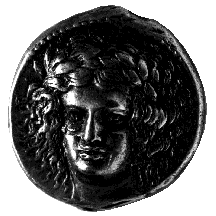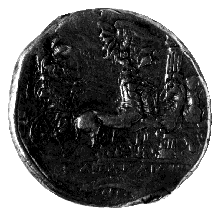



(9) Katane, Sicily (Italy) - AR tetradrachm, c. 431-404
B.C., 17.29 g. (inv. 93.006).
Obverse: Facing head of Apollo wearing laurel wreath; to
r. ![]() : Herakleidas.
: Herakleidas.
Reverse: Quadriga racing r. past Ionic column; Nike flying
above horses; in exergue, crayfish, ![]() : of the Katanians.
: of the Katanians.
Provenance: Harlan Berk, 1992.
Bibliography: C.M. Kraay, Archaic and Classical Greek
Coins (Berkeley and Los Angeles 1976) 224-225.
Katane was a colony of Sicilian Naxos (see no. 14)
south of Mt. Etna. In the early fifth century it incurred the wrath of Syracuse,
whose tyrant Hieron expelled its inhabitants, but they returned c. 461 B.C.
In 415 B.C. Katane served as the base for the Athenians' unsuccessful invasion
of Syracuse. Notwithstanding the years of trouble with the city, the coins
of Katane show considerable Syracusan influence.
At the end of the fifth century, a number of master die-engravers who signed
their coins were employed at Katane. One was Euainetos, best known for his
racing quadrigas on the coins of Syracuse (see no. 19).
Another was Herakleidas, whose signature is barely legible on the obverse
of this coin. In the facing Apollo of the obverse of this coin, Herakleidas
was probably influenced by the contemporary facing heads of Kimon (see no.
17) and Eukleidas (see no. 16)
on Syracusan coins. His heads of Apollo have a similar fleshiness and luxuriant
hair. The reverse also shows Syracusan influence; the racing quadriga had
long been used as the main obverse type on Syracusan coins. The column in
the background of the scene provides a sense of depth, which is also characteristic
of Syracusan coins of the period.
C.L.L.



All contents copyright (c) 1996.
Lawrence University
All rights reserved.